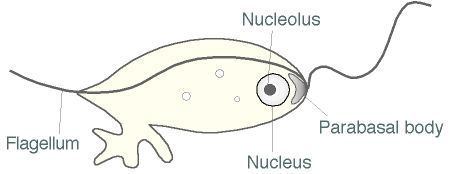Domain Eukaryota Class Sarcomonadea | Rank Order | |
 | ||
Similar Cercomonas, Imbricatea, Cercozoa, Spongomonadea, Desmothoracid | ||
Cercomonads are small flagellates, widespread in aqueous habitats and common in soils.
Contents
Characteristics
The cells are generally around 10 μm in length, without any shell or covering. They produce filose pseudopods to capture bacteria, but do not use them for locomotion, which usually takes place by gliding along surfaces.
Most members have two flagella, one directed forward and one trailing under the cell, inserted at right angles near its anterior. The nucleus is connected to the flagellar bases and accompanied by a characteristic paranuclear body.
Classification
Genetic studies place the cercomonads among the Cercozoa, a diverse group of amoeboid and flagellate protozoans. They are divided into two families.
The classification of genera and species continues to undergo revision. Some genera have been merged, like Cercomonas and Cercobodo, and some have been moved to other groups.
